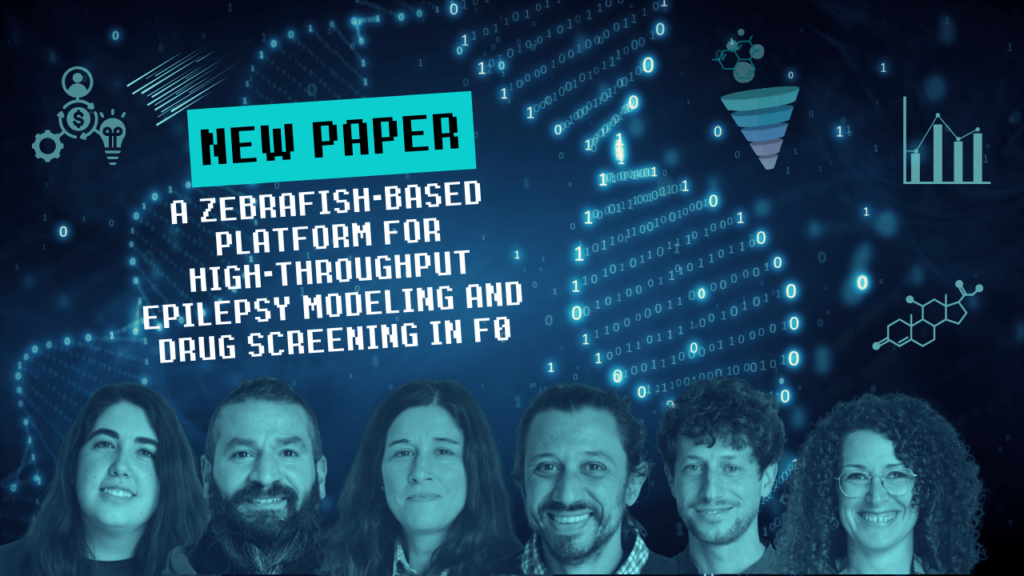Miriam Martínez - 19 March 2024
Fast Gene Target Validation & Drug Screening All In One
Harness the potential of our new Zebrafish-Based Platform for High-Throughput Gene Target Validation and Drug Screening in F0

In this blog, we are dissecting the essential features of our innovative platform, designed to streamline your genetic target identification and therapeutic candidate screening process.
This study focuses on neurodevelopmental disorders (NDDs), especially genetic epilepsy, but could be applied to any therapeutic area of your choice.
Zebrafish, a key tool for phenotypic drug screening
The zebrafish model has emerged as a key tool for phenotypic drug screening. A growing number of compounds have been transitioned from experimental settings to clinical applications in the past decade, thanks to zebrafish-based assays.
The significant genetic similarity between zebrafish and human genomes (82% of human morbid genes have at least a zebrafish ortholog) allows the creation of zebrafish lines with mutations in disease-relevant genes. However, even with this alternative model, establishing isogenic mutant lines requires a lengthy generation period.
How do we reduce model generation time?
We understand how important it is for you to accelerate the drug and target discovery process. For this reason, we have developed a zebrafish-based high-throughput platform for rapid target validation and drug screening already in F0 knockout models.
It means that we can directly evaluate behavior and other complex phenotypes in injected fish (F0 generation) eliminating the need to wait months to establish an isogenic mutant line.
So, in just three months, we can screen your candidate genes and molecule library to identify targets and evaluate compound efficacy.
An innovative strategy
Co-targeting genes of interest and tyr loci
The CRISPR/Cas9 technology was used to create mutations in target genes of interest in zebrafish F0 larvae. The procedure was optimized by co-targeting an endogenous "reporter" gene (tyrosinase) to identify larvae with the highest mutation rate.
Tyrosinase, an enzyme responsible for melanin production, determines skin pigmentation. Thus, individuals lacking tyrosinase exhibit depigmented skin, making this trait a convenient marker for identifying gene knockouts.
Our strategy allows the preselection of de facto mutant larvae before performing phenotypic characterization, thus enabling the study of less genetically heterogeneous populations for inferring gene function.
We hypothesize that a similar result can be obtained by targeting other sequences whose inactivation results in a visually detectable phenotype (e.g., the GFP CDS in a transgenic reporter line), making this approach extremely flexible and versatile.
Rapid gene target validation
Selected F0 knockouts are then phenotypically characterized to infer gene function and validate gene targets. To do so, we can combine our high-throughput morphological and behavioral phenotyping platforms on demand.
High throughput drug screening platform
After the genetic validation of the F0 knockout model, we expose the larvae to candidate therapeutic compounds to identify active drugs able to reverse the mutation-induced phenotype.
A Zebrafish-Based Platform for High-Throughput Epilepsy Modeling and Drug Screening in F0
1. We efficiently generated F0 mutants in seven genes involved in childhood epilepsy.
Tyrosinase loss of function allows the selection of crispants carrying a high rate of mutations in targeted genes.
2. In order to address the phenotypic heterogeneity of epilepsy, morphological and behavioral assessments were combined to characterize the response of these knockout models to an epileptogenic stimulus.
Different responses to epileptogenic stimuli were identified in larvae with mutations in different genes. The recapitulation of epilepsy features in these crispants (F0 knockouts) demonstrates the utility of zebrafish F0 mutants in modeling epilepsy.
3. A multiparametric analysis of behavioral response to light flashes was performed to detect seizure-like events, and classify larval responses to light stimuli.
This fine characterization of photosensitive epilepsy allowed us to identify genes associated with increased light sensitivity.
4. Finally, a platform for anti-seizure medication (ASM) screening using specific F0 larvae mutations was established.
We demonstrated that known compounds (valproic acid and fenfluramine) can prevent light-induced epileptic events, highlighting the utility of zebrafish crispants in screening anti-seizure medications.
Revolutionizing Target Identification & Drug Screening
In summary, the study proposes an innovative and optimized strategy in advancing target identification, disease modeling and phenotypic-based drug screening with a particular focus on genetic epilepsy, using zebrafish larvae as experimental model.
The simultaneous inactivation of target genes along with an endogenous reporter locus enables the efficient selection of zebrafish larvae with the highest mutation rate. Coupled with high-throughput phenotypic screening in F0 knockout larvae, this approach offers comprehensive analysis capabilities in record time.
This zebrafish-based platform paves the ground for personalized medicine development. In just three months, our platform enables the generation of a model for the affected gene in individual patients and testing of the most effective medication.
 By Miriam Martínez
By Miriam Martínez
Miriam is a Human Biologist expert in neuropharmacology. After a master’s degree in Pharmaceutical and Biotech Industry, she obtained her PhD in Biomedicine from Pompeu Fabra University (Barcelona). During her doctorate, she focused her research on the behavioral analysis of animal models for neurophenotypical characterization. Since then, she has been working in the healthcare marketing and publicity sector, where she has contributed to developing marketing campaigns for several pharmaceutical brands. In 2021, she joined ZeClinics with a branding and marketing strategy focus.